With today’s exponential advancement of technology, contact lenses are evolving in much the same way telephones have over the past few years. The smartphone’s role of making and receiving calls is now overshadowed by its ability to access the internet, provide real-time driving directions, take photos and video and summon transportation, just to name a few. In analogous fashion, contact lenses are now moving beyond simply correcting refractive error into the category of “smart contact lenses.” For example, the Vistakon division of Johnson & Johnson Vision Care’s product pipeline and patent activity reveals contact lenses designed to release an anti-allergy drug (with plans to file a New Drug Application in 2017) and a photochromic contact lens that adapts to the ambient light level, offering “glare and eyestrain relief.”1,2
Perhaps the most profound applications will come from contact lenses embedded with microelectronic sensors, actuators and components to transfer energy and data. The miniaturization of electronics and advances in consumer electronics bring forth possibilities that once seemed like a moonshot. In vision correction, contact lenses may soon deliver adaptations that will transform the perceived world of both wearer and prescriber. Contact lenses will allow health monitoring and augmented reality, not to mention photo and video recording. In short, contact lenses will join the increasing web of interconnectivity, where devices collect data with sensors, allowing cloud-based analysis and real-time action.
Let’s review what’s in the works with smart contact lenses and discuss the implications for consumers and eye care professionals.
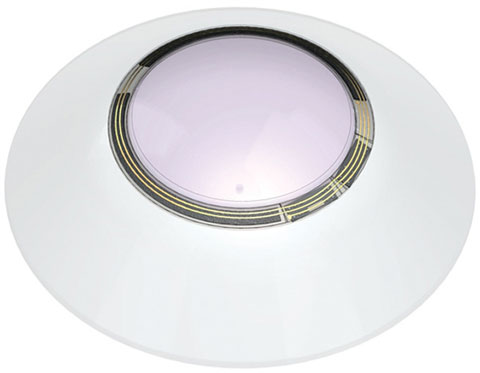 |
| Fig. 1. An accommodating contact lens presented by Johnson & Johnson Vision Care at its May 18, 2016 investor meeting.1 Photo: Johnson & Johnson Vision Care |
Accommodating Optics
Presbyopia remains the basis for many consumers’ need for eye exams, corrective eyewear and refractive surgery. Yet none of these modalities have managed to replicate natural accommodation with “autofocusing” optics. The common contact lens strategies for presbyopia degrade the quality of distance vision to improve near vision, through monovision or simultaneous vision multifocality. Thus, the prospect of an accommodating contact lens is quite attractive, and Verily (formerly Google Life Sciences) and Alcon, a division of Novartis, hope to have a product to meet this need.
“We have developed a prototype of the accommodating contact lens—for complex, cutting-edge technology, the projects are progressing steadily,” said Brian Otis, PhD, chief technology officer at Verily, in an exclusive e-mail interview in December 2016.
Johnson & Johnson is also making headway in this field (Figure 1). “In a newly created area, smart device technology, which combines contact lenses with sensors and microprocessors, we have already created a very strong portfolio: 82 US-issued patents and over 130 US pending applications,” stated Peter Shen, PhD, worldwide vice president of Research and Design for Johnson & Johnson Vision Care at its May 18, 2016, investor meeting.1 “Our smart device technology platform will enable us to explore opportunities to embed sensors, microprocessors, into contact lenses—very, very exciting opportunities.” He also emphasized that the “first indication will be for the treatment of presbyopia.”1 A search of patents filed by Johnson & Johnson Vision Care suggests its smart contact lens for presbyopia will achieve variable focus using electro-active liquid crystal elements.3,4
eVision is developing an electrically-modulated contact lens which, according to Joel D. Zychick, president and CEO, “will be the only flexible contact lens, giving the end-user the ability to choose from a variety of prescription settings and to dynamically change focus while correcting for a variety of visual impairments, including myopia, hyperopia and higher-order aberrations.” The company’s first prototype was supposed to be available by late 2016.5 Several attempts in November 2016 to obtain an update were unsuccessful.
Another accommodating contact lens concept has been developed by Hongrui Jian, PhD, and his team from University of Wisconsin, Madison, which was inspired by the eyes of the elephant nose fish. Jian’s work, funded by the National Institutes of Health (NIH), involves a contact lens that uses tunable liquid powered by a solar cell that harvests and stores the energy within a network of nanostructures.6
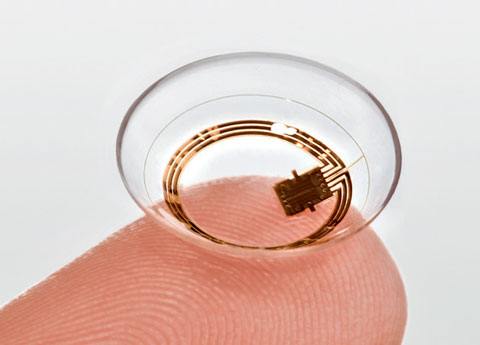 |
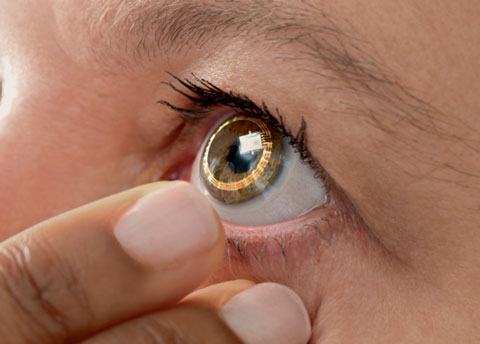 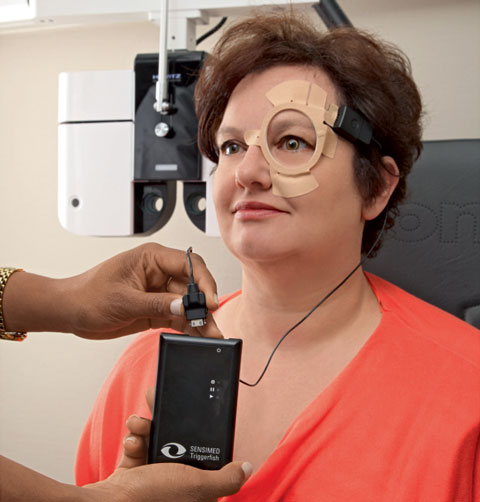 |
| Fig. 2. At the top, Sensimed’s Triggerfish for detecting ocular dimensional changes. Second from the top, the lens on the eye. At the bottom, sensor data is collected by an adhesive-backed antenna worn around the eye, connected to a portable data recorder. Photos: Sensimed |
Health Monitoring
Smart contact lenses are thought to be great tools for the detection and monitoring of biomarkers of disease since the tear film contains minerals, lipids and proteins.7 In particular, contact lenses are emerging to monitor glaucoma risk and glucose control in a manner similar to how the Fitbit activity tracker can monitor and provide information on heart rate and steps taken.
Sensimed received FDA market clearance in March 2016 for Triggerfish, a single-use silicone contact lens embedded with a microsensor to detect tiny fluctuations in the eye’s volume, capturing spontaneous circumferential changes at the corneoscleral area (Figure 2). Triggerfish is worn for up to 24 hours and wirelessly transmits ocular dimensional changes to an antenna placed around the eye with adhesive. A portable data recorder worn by the patient collects the information from the antenna and transfers it via Bluetooth to software installed on the practitioner’s computer. The resulting data profile provides the practitioner with the time of day the eye’s volume, which closely correlates with the patient’s IOP, is highest and lowest.8 Triggerfish does not, however, directly measure IOP. The product information states the technology is not intended to diagnose and is not for correcting vision.
While there doesn’t seem to be immediate plans to commercialize Triggerfish in the United States, Sensimed is collaborating with a Japanese manufacturer and collecting clinical data on patients with normal tension glaucoma. Additionally, Sensimed is looking for a strategic partner in the United States to execute a planned prospective study comparing fast vs. slow-progressing glaucoma, according to an October 2016 company press release.9
Two separate efforts to commercialize a contact lens for continuous glucose-monitoring are underway. The target market is the 29.1 million with diabetes in the United States and the 387 million with diabetes globally.10,11 The promise is to offer patients a noninvasive method, instead of a finger prick, to track glucose levels.12 Although researchers still debate how well glucose levels in the tears correlate with blood glucose levels, it does not appear to dampen development attempts.13 The first effort by Verily was announced in January 2014, and Novartis was announced as a partner in July 2014.14
“The smart lens projects, including the glucose sensing lens, remain active, and both Alcon and Verily are pleased with the progress of the collaboration to date,” according to Dr. Otis of Verily. “Elements of the smart lens technology we are developing are in early clinical development. The tools we are developing are intended to passively monitor people’s health-related behaviors so that they can more easily manage their conditions, rather than having to regularly check on themselves throughout the day. We consider these devices complementary to the patient-provider relationship, as doctors may have more data points to consider when making a diagnosis or considering treatment options.”
The second effort is by Medella Health, a Canadian start-up with $1.4 million in seed funding. In an exclusive phone interview, Harry Gandhi, CEO of Medella Health, said his team is developing a smart contact lens platform with a microchip, sensor, power and communication components (Figure 3). “Bio-sensing the tear film represents the low-hanging fruit of development compared to other applications of smart contact lenses such as augmented reality,” Mr. Gandhi said. “We found, based on countless interviews, that consumers are willing to invest in their own preventative health.”
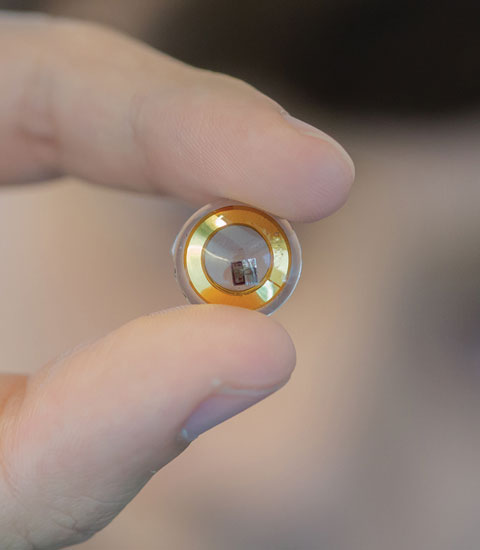 |
| Fig. 3. Prototype of a continuous glucose-sensing contact lens. Photo: Medella Health |
Augmented Reality
Last year’s Pokémon Go craze, where Pokémon appeared on users’ smartphone camera screens, highlighted the recent consumer drive toward augmented reality (AR). The National Football League has been using the computer-generated yellow first-down line for years now, and soon technology will be able to superimpose real-time directions on what you see while driving your car. This is the world of mixed reality (MR)—where digital content is placed over the normal vision content—and AR, where the digital content is registered and fixed to normal vision content. MR and AR are fast becoming their own form of reality, promising to deliver mobile content, including social media and streaming text and video, in your normal field of view in eyewear.
Many consumer electronics companies are chasing MR and AR, as well as virtual reality (VR), where the world around you is occluded. Smartphone accessories such as Google Cardboard, Zeiss VR and Samsung’s Gear VR provide somewhat immersive VR experiences, as do the dedicated headsets such as Facebook’s Oculus Rift, Sony PlayStation VR, HTC Vive and others. MR and AR offerings include Vuzix Blade 3000, Microsoft’s HoloLens, Meta glasses, Osterhout Design Group’s smartglasses system and Sony SmartEyeglass, to name a few. Yet the bulkiness, obtrusiveness, heat generation and small field of view with these devices are limiting. This is where smart contact lenses come into play.
Innovega recently completed a fourth round of clinical trials at the Ohio State University with the iOptik contact lens-enabled wearable display technology.15,16 The soft disposable contact lens has a linear polarizer filter in the distance optical zone of the lens that blocks the near eye display light and a 1.0mm center microlens that focuses the display light in the lightweight display eyewear (Figure 4). “The eye-borne optics make a wide field of view, simultaneous viewing of the display and the real world, lightweight eyewear, low power consumption, high resolution, reduced vergence-accommodation conflict, and wide range of augmented, mixed and virtual reality eyewear configurations possible,” said Steve Willey, Innovega CEO, in an interview. The company anticipates starting FDA clinical trials in 2017.
The first clinical use for the iOptik system is for patients with low vision. The NIH recently granted Innovega a Phase I Small Business Innovation Research grant to investigate the low vision application. A minimum field of view to deliver more than 4x image amplification and retain significant context is estimated at 50 degrees. Innovega has a prototype that delivers more than a 100-degree field of view using the contact lens. “The same contact lens-enabled systems can provide enhanced vision for fully sighted users,” Mr. Willey said.
Samsung has been granted a patent in South Korea for a contact lens with a display that projects images into the user’s eye.17 The Gear Blink trademark, filed in both South Korea and the United States, may have to do with this smart contact lens and may involve blinking to control activation.
Night vision contact lenses, described by researchers at University of Michigan and Massachusetts Institute of Technology, are another form of MR and AR.18,19 The concept uses graphene, a one-atom thick layer of carbon, to detect the infrared spectrum in combination with signal amplification. While the idea of night vision contact lenses is intriguing, significant research and development is needed.
Photo and Video Recording
The rise of social media has placed increased value on the ability to capture photos and video through the user’s point of view.20 Here, contact lenses with photo and video recording could be the ultimate wearable.
Sony and Samsung each have patent applications for contact lenses that record what you see, and they both propose using the blink to control activation.21,22 Samsung’s patent application shows their lens is equipped with a tiny display, camera, antenna and several sensors to detect movement. An external device such as a smartphone is needed for processing.17 Sony’s patent shows a contact lens with a built-in camera, storage and transmission unit, as well as features including autofocus, zoom, aperture control and image stabilization. In all these cases, the patent applications describe product concepts rather than actual final products.
News reports suggest Google may also be pursuing such contact lens technology.23
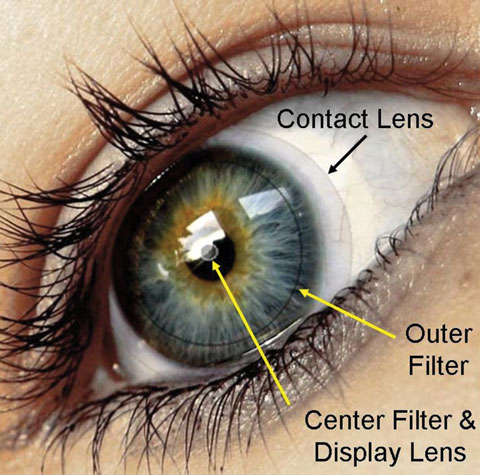 |
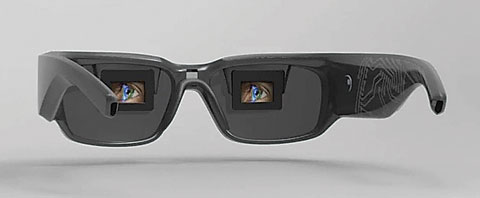 |
| Fig. 4. Above, Innovega iOptik’s soft disposable contact lens with a linear polarizer filter in the distance optical zone for blocking the eyewear’s polarized display and a 1.0mm center microlens that focuses the eyewear’s microdisplay. Below, the iOptik eyewear for immersive virtual reality. Click top image to enlarge. Photos: Innovega |
Implications
With so many innovations in the pipeline, smart contact lenses that enable accommodation, health monitoring, VR, MR, AR and photo and video recording may one day become the preferred platform to connect to our digital world. Until that time, many questions persist.
Will smart lenses for presbyopia finally crack the code of restoring natural accommodation? If so, we predict a resurgence in consumer and practitioner interest in contact lenses for presbyopia, significantly expanding the contact lens market.
Health monitoring wearables are ushering in a trend toward data-driven healthcare. While the initial efforts emphasize monitoring health status, health monitoring wearables may one day lead to data-driven diagnosis, which could replace the role of common physician functions in a manner that is more efficient, accurate and cost-effective to the consumer.24 Still, it is not clear whether consumers will make bad medical decisions based on faulty interpretation.
For digital device users, much has been said about how our smartphones and tablets are distracting us to the point of sickness.25 While most incoming messages are inconsequential, the reward of “good news” creates device addiction that can interfere with our personal relationships and true connection. The future user interface through mixed reality and augmented reality, if designed well, could minimize the unfortunate phenomena of being together yet isolated in our individual digital worlds.
The prospect of photo and video recording with contact lenses will create concern for their use in financial institutions, casinos, child-care centers, public restrooms, private social settings, test-taking centers and movie theaters, to name few. Some recording eyewear has tried to minimize this concern by implementing a recording light that turns on when it is in use. Yet, such a visual reassurance may not be possible with contact lenses.
Smart contact lens wearers might have to contend with security concerns as well, if the communication system is vulnerable to hacking or malfunction. For example, imagine the catastrophe for an accommodating contact lens wearer if full accommodation is unexpectedly activated while the user is driving at high speed. Or if video data is intercepted from a user’s smart contact lens in the same manner that hackers take control of a laptop’s webcam. These concerns are not insurmountable; yet, they underscore the importance of developing secure technology for smart contact lens wearers.
Smart CLs in Your Office
Meanwhile, optometrists wonder what part they may play with smart contact lenses. With accommodating contact lenses, our integral role is obvious. For health-sensing contact lenses, Mr. Gandhi of Medella Health believes that optometrists in the United States will be pivotal in bringing patients onboard. “It’s an exciting future because these smart contacts will create a closer working relationship between the optometrist and patient’s primary care physician or endocrinologist,” Mr. Gandhi said. Smart contact lenses with AR and photo and video functions will most likely require prescribing and progress visits by eye care practitioners. Additionally, these smart contact lenses may share a consumer-driven paradigm with cosmetic contact lenses, in which patients tend to request them from the doctor rather than doctors recommending them to patients. Dr. Otis said Verily’s smart contact lens technology “has the potential to transform eye care, and we anticipate that both ECPs and consumers will play a role in its adoption.”
The development efforts in smart contact lenses are significant and indicate a new era for patients and practitioners. Just as Alexander Graham Bell would be stunned by today’s smartphone, Otto Wichterle, who developed the material for the first soft lens, would surely react the same way to smart contact lenses.
Dr. Chou is a partner at EyeLux Optometry in San Diego, Calif., where he directs a referral-based keratoconus clinic. He serves as an expert witness for medicolegal cases and consultant to several ophthalmic companies.
Dr. Legerton is an author, lecturer, inventor and consultant to the ophthalmic industry. He is a cofounder of SynergEyes and Innovega and has 52 issued US patents for contact lens technology including SynergEyes, Paragon CRT, myopia progression control, presbyopic laser refractive surgery and novel multifocal contact lenses.
|
1. Johnson & Johnson Consumer and Medical Devices Business Review. Webcast. May 18, 2016; New Brunswick, NJ. Available at www.investor.jnj.com/webcasts-presentations.cfm. Accessed November 30, 2016. 2. Pupil-only photochromic contact lenses displaying desirable optics and comfort. US Patent 20140098339 A1. Available at www.google.com/patents/US20140098339. Accessed November 30, 2016. 3. Method and apparatus for ophthalmic devices comprising dielectrics and nano-scaled droplets of liquid crystal. US Patent 9442309 B2. Available at www.google.com/patents/US9442309. Accessed November 30, 2016. 4. Variable focus ophthalmic device including liquid crystal elements. US Patent 8906088 B2. Available at www.google.com/patents/US8906088. Accessed November 30, 2016. 5. e-Vision accelerates development program for first fully tunable electronic contact lens. Market Wired. November 12, 2015. Available at www.marketwired.com/press-release/e-vision-accelerates-development-program-first-fully-tunable-electronic-contact-lens-2073281.htm. Accessed November 30, 2016. 6. Fish and insects guide design for future contact lenses. National Institutes of Health. Available at www.nih.gov/news-events/news-releases/fish-insects-guide-design-future-contact-lenses. Accessed November 30, 2016. 7. Phan CM, Jones LW, Subbaraman L. The use of contact lenses as biosensors: a clinical perspective. Optom Vis Sci. 2016;93:419-25. 8. Mansouri K, Medeiros FA, Tafreshi A, Weinreb RN. Continuous 24-hour monitoring of intraocular pressure patterns with a contact lens sensor: safety, tolerability, and reproducibility in patients with glaucoma. Arch Ophthalmol. 2012;30:1534-9. 9. Sensimed enters into a strategic collaboration and financing agreement with SEED, a Japanese contact lens manufacturer. Raises CHF 10M through a convertible loan. Sensimed. October 18, 2016. Available at www.sensimed.ch/images/pdf/PR_2016-10-18_sensimed_financing_agreement_SEED_Japan_E.pdf. Accessed November 30, 2016. 10. Centers for Disease Control and Prevention. Diabetes data and statistics. Available at www.cdc.gov/diabetes/data/index.html. Accessed November 30, 2016. 11. International Diabetes Foundation. Diabetes: facts and figures. Available at www.idf.org/about-diabetes/facts-figures. Accessed November 30, 2016. 12. Ascaso F, Huerva V. Continuous monitoring of tear glucose using glucose-sensing contact lenses. Optom Vis Sci. 2016;93:426-34. 13. ‘Silicon Valley arrogance’? Google misfires as it strives to turn Star Trek fiction into reality. STAT News. Available at www.statnews.com/2016/06/06/google-star-trek-fiction. Accessed November 30, 2016. 14. Introducing our smart contact lens project. Google Blog. January 16, 2014. Available at https://googleblog.blogspot.com/2014/01/introducing-our-smart-contact-lens.html. Accessed November 30, 2016. 15. Sprague R, Schwiegerling J. Full field-of-view augmented reality using contact lenses. Paper presented at the Interservice/Industry Training, Simulation, and Education Conference, November 29-December 2, 2010; Orlando, Fla. 16. Bernstein J. 2012 Invention awards: augmented-reality contact lenses. Pop Sci. June 5, 2012. Available at www.popsci.com/diy/article/2012-05/2012-invention-awards-augmented-reality-contact-lenses. Accessed December 5, 2016. 17. Samsung is working on smart contact lenses, patent filing reveals. SamMobile. April 5, 2016. Available at www.sammobile.com/2016/04/05/samsung-is-working-on-smart-contact-lenses-patent-filing-reveals. Accessed November 30, 2016. 18. Graphene gives you infrared vision in a contact lens. IEEE Spectrum. March 17, 2014. Available at http://spectrum.ieee.org/nanoclast/semiconductors/optoelectronics/graphene-gives-you-infrared-vision-in-a-contact-lens. Accessed November 30, 2016. 19. Hsu AL, Herring PK, Gabor NM, et al. Graphene-based thermopile for thermal imaging applications. Nano Lett. 2015;15(11):7211-6. 20. The weird way Facebook and Instagram are making us happier. Wired. March 23, 2015. Available at www.wired.com/2015/03/stuffocation-the-weird-way-facebook-and-instagram-make-us-happier. Accessed November 30, 2016. 21. Sony patents contact lens cam with zoom, aperture control, and more. PetalPixel. April 28, 2016. Available at http://petapixel.com/2016/04/28/sony-patents-contact-lens-camera-joins-google-samsung. Accessed November 30, 2016. 22. Samsung patents smart contact lenses with a built-in camera. Mashable. April 5, 2016. Available at http://mashable.com/2016/04/05/samsung-smart-contact-lenses-patent/#7DFPE3pI9aqw. Accessed November 30, 2016. 23. After Google Glass, Google developing contact lens camera. Cnet. April 15, 2014. Available at www.cnet.com/au/news/after-google-glass-google-developing-contact-lens-camera. Accessed November 30, 2016. 24. Topol E. The Patient Will See You Now: The Future of Medicine is in Your Hands. New York, NY: Basic Books; 2015:384. 25. Sullivan A. I Used to Be a Human Being. New York Magazine. September 18, 2016. Available at http://nymag.com/selectall/2016/09/andrew-sullivan-technology-almost-killed-me.html. Accessed November 30, 2016.1. |

